If you’re a fan of sweet, colorful, and refreshing desserts, then you’re in for a treat with “che Thai“.This delicious Vietnamese dessert is a popular and beloved part of Vietnamese cuisine, and it’s easy to see why. With its combination of fresh fruits, creamy coconut milk, and sweetened beans, che thai is a dessert that is both satisfying and refreshing, making it the perfect treat for a hot day or a special occasion.
As a traditional dessert that has been enjoyed in Vietnam for generations, che thai has a rich history and cultural significance that adds to its appeal. From its ingredients to its presentation, every aspect of che thai is carefully crafted to create a unique and delightful dessert that is both beautiful to look at and delicious to eat.
In this article, I will delve deeper into the world of che thai and explore its origins, ingredients, recipe, variations, health benefits, serving suggestions, cultural significance, and more. Whether you’re a fan of traditional recipes or modern twists, this article has everything you need to know about this popular Vietnamese dessert. So, let’s dive in and discover the vibrant and colorful world of che thai!
What is che thai?
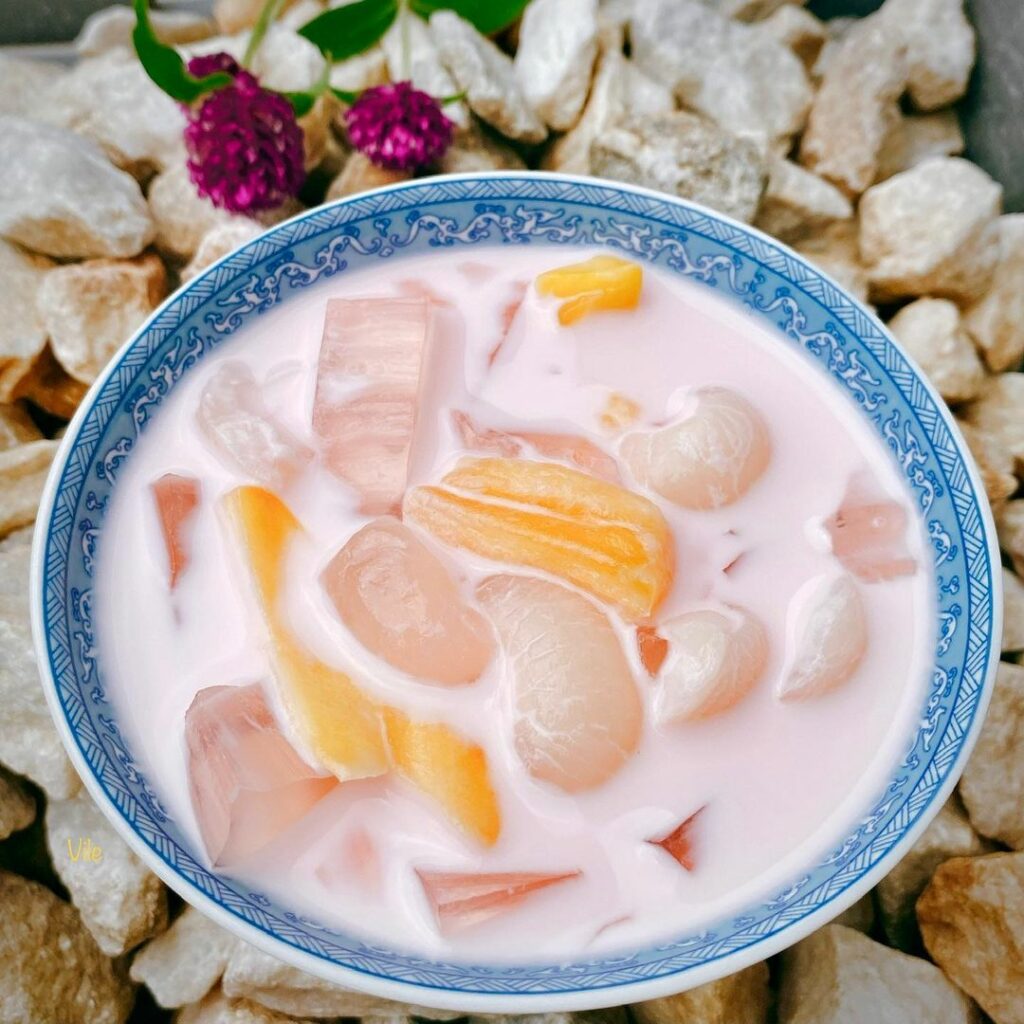
Che thai is a popular Vietnamese dessert that consists of a colorful mix of fruits, beans, jelly, and coconut milk. The dessert is known for its refreshing taste and vibrant appearance, making it a popular choice among locals and tourists alike.
Where did che thai come from?
The origin of che thai is not entirely clear, but it is believed to have its roots in the southern region of Vietnam. Some historians suggest that che thai may have been influenced by Thai cuisine, given its name and the use of coconut milk in the dessert.
In Vietnamese culture, che thai is often served during special occasions such as weddings, Lunar New Year celebrations, and other festivals. It is also a popular dessert in restaurants and street food stalls throughout Vietnam.
Che thai has become increasingly popular worldwide, with many Vietnamese restaurants and food bloggers featuring their own variations of the desert. It’s refreshing taste and colorful appearance makes it a unique and enjoyable dessert for all ages.
Why che thai is becoming popular worldwide?
Che thai are becoming popular worldwide due to its unique combination of flavors, refreshing taste, and vibrant appearance. As more people become interested in exploring different cuisines and cultural experiences, che thai has gained attention for its distinct Vietnamese flavors and ingredients.
Che thai Vietnamese dessert that can be easily customized to suit different tastes and preferences. With a wide variety of fruits, beans, and jellies to choose from, the dessert can be tailored to fit any dietary restrictions or flavor preferences. Its versatility and adaptability make it an attractive dessert option for many people.
The visually stunning appearance of che thai, with its colorful and layered ingredients, makes it an ideal dessert for Instagram and other social media platforms.
Che thai’s unique combination of flavors, adaptability, and visual appeal have contributed to its growing popularity worldwide. As more people discover the joys of Vietnamese cuisine, che thai is sure to remain a favorite dessert for years to come.
What does che thai taste like?
Che thai has a unique and refreshing taste that is hard to compare to any other dessert. The dessert has a sweet and slightly creamy flavor, with a hint of coconut milk and a variety of fruit flavors.
The dessert’s sweetness is balanced by the subtle tartness of the fruits, making it a delightful and refreshing treat.
Che thai’s taste can be described as sweet, refreshing, and slightly creamy, with a variety of fruit flavors and a slightly chewy texture.
Che thai recipes
If you’re looking to make a delicious and refreshing dessert that is sure to impress your guests, then you’ll love this che thai recipe. This dessert is a colorful mix of fresh fruits, jelly, beans, and coconut milk that is sure to satisfy any sweet tooth. Some of the ingredients for this recipe may be hard to find in certain areas. However, you can find them in Asian grocery stores or online. Here’s what you need to know to make this delightful dessert:
Cooking note
- Yield: 6 servings
- Prep time: 20 minutes
- Cook time: 10 minutes
- Total time: 30 minutes
- Course: Dessert
- Cuisine: Vietnamese
- Equipment: Large bowl, medium saucepan, measuring cups and spoons, knife, cutting board, mixing spoon.
List of ingredients
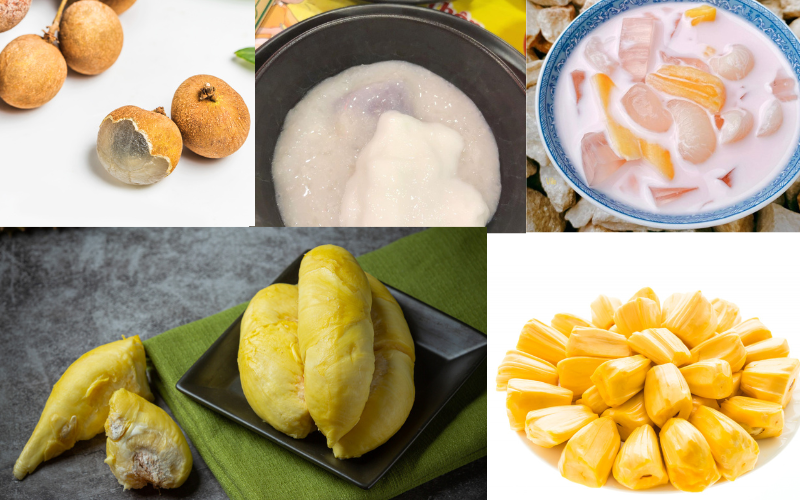
Best che thai recipe:
- 1 can of coconut milk (400ml)
- 1/4 cup of sugar
- 1/4 tsp of salt
- 1/2 cup of water
- 1/4 cup of tapioca pearls
- 1/4 cup of red beans
- 1/4 cup of green beans
- 1/4 cup of jackfruit (cut into small pieces)
- 1/4 cup of lychees (peeled and seeded)
- 1/4 cup of longan (peeled and seeded)
- 1/4 cup of cubed agar jelly
Where to find the ingredients?
Che thai ingredients including coconut milk, tapioca pearls, red beans, green beans, jack fruit, lychees, longan, and agar jelly can be found in Asian grocery stores or online.
If you can’t find these ingredients, you can substitute them with other fruits or beans of your choice.
By following this recipe, you can create a delicious and authentic che thai dessert that is sure to impress your guests. With its colorful appearance and refreshing taste, this dessert is perfect for any occasion.
Read more: Vietnamese Yogurt Recipe
Substitutes for hard-to-find ingredients
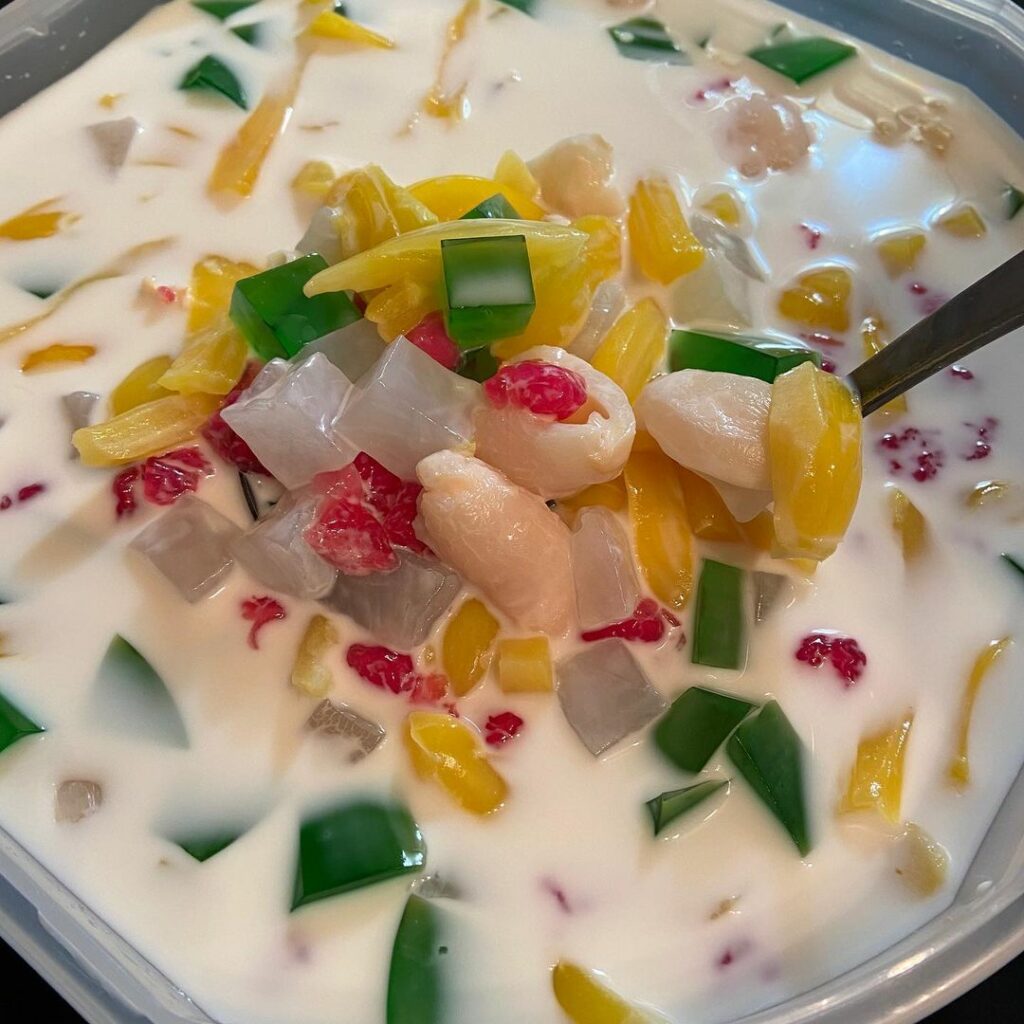
If you are having trouble finding some of the ingredients for che thai, there are several substitutes that you can use to create a similar taste and texture. Here are some substitutes for hard-to-find ingredients:
- Tapioca pearls: If you can’t find tapioca pearls, you can use sago pearls or small pearl couscous instead. These substitutes have a similar texture and can be cooked in the same way as tapioca pearls.
- Red beans and green beans: If you can’t find red or green beans, you can use kidney beans or black beans instead. These substitutes have a similar taste and texture to red and green beans and can be used in the same way.
- Jackfruit: If you can’t find fresh jackfruit, you can use canned jackfruit or canned tropical fruit salad. These substitutes have a similar texture and taste to fresh jackfruit.
- Lychees and longan: If you can’t find fresh lychees or longan, you can use canned lychees or longan. These substitutes have a similar taste and texture to fresh lychees and longan.
- Agar jelly: If you can’t find agar jelly, you can use gelatin instead. These substitutes have a similar texture and can be used in the same way as agar jelly.
By using these substitutes, you can still create a delicious and authentic che thai dessert, even if you can’t find all the traditional ingredients.
More Che recipe:
- Creamy and Delicious Taro Pudding (Che Khoai Mon) Recipe
- Best Steamed Vietnamese Flan (Banh Flan, Vietnamese Creme Caramel) Recipe
Table nutrient facts of che thai
Here is a table of the nutrient facts for che thai based on a typical recipe:
| Nutrient | Amount |
| Calories | 209 |
| Total Fat | 7.8g |
| Saturated Fat | 6.5g |
| Cholesterol | 0mg |
| Sodium | 42mg |
| Total Carbohydrate | 34.6g |
| Dietary Fiber | 1.9g |
| Total Sugars | 20.8g |
| Protein | 2.3g |
| Vitamin D | 0mcg |
| Calcium | 23mg |
| Iron | 1mg |
| Potassium | 310mg |
From the table, we can see that che thai is moderately high in calories and total fat, mainly due to the use of coconut milk. However, it is low in cholesterol and sodium, making it a healthier dessert option compared to many other desserts, so “is Vietnamese che thai healthy“, that question will help u know it.
Che thai also provides a good amount of dietary fiber, which can help with digestion and weight management.
In terms of vitamins and minerals, che thai provides a moderate amount of calcium, iron, and potassium. However, it is not a significant source of other essential vitamins and minerals.
While che thai is not a low-calorie dessert, it can be a healthy and nutritious option when consumed in moderation as part of a balanced diet. As with any dessert, it is best to enjoy che thai in moderation and to balance it out with plenty of whole foods, fruits, and vegetables.
How to make che thai?
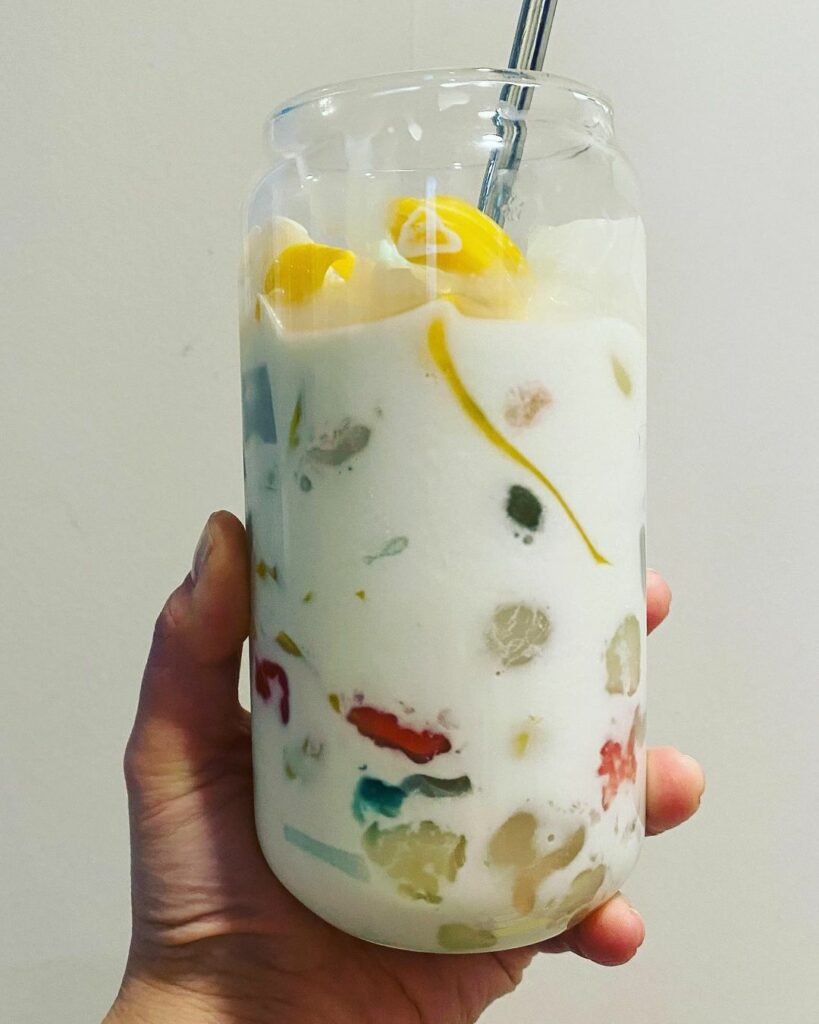
If you’re looking for the best che thai recipe “how to make che thai” at home, look no further! Here is a step-by-step guide on how to make delicious and refreshing che thai:
Instructions
- Rinse the tapioca pearls and soak them in water for 30 minutes.
- Cook the tapioca pearls in boiling water for 15 minutes, stirring occasionally.
- Drain the tapioca pearls and rinse them with cold water. Set aside
- In a medium saucepan, combine the coconut milk, sugar, salt, and water. Heat the mixture over medium heat, stirring constantly, until the sugar dissolves.
- Add the red beans, green beans, jackfruit, lychees, and longan to the coconut milk mixture. Stir well and cook for 5 minutes.
- Add the agar jelly and cooked tapioca pearls to the mixture. Stir well and cook for another 2 minutes.
- Remove the saucepan from heat and let the mixture cool down to room temperature.
- Transfer the che thai to a large bowl and refrigerate for at least 30 minutes before serving.
Tips for making the perfect che Thai
- Use fresh ingredients whenever possible to ensure the best flavor and texture.
- Adjust the amount of sugar to your taste. Some people prefer their che thai to be sweeter, while others prefer it to be less sweet.
- Make sure to cook the tapioca pearls until they are fully transparent. Undercooked tapioca pearls can have a chewy and unpleasant texture.
- Experiment with different fruits and beans to create your own unique che thai recipe.
- Serve che thai cold for the best flavor and texture.
With these tips and this recipe, you can create the perfect che thai dessert that is sure to impress your family and friends.
Read more: Vietnamese Honeycomb Cake – Banh Bo Nuong Recipe
What are service suggestions?
Serving suggestions are recommendations for how to present and serve a particular dish. In the case of che thai, a popular Vietnamese dessert, there are several traditional and modern serving methods that you can use to showcase this colorful and delicious dessert.
Serving suggestions for che thai
- Traditional serving method: In Vietnam, che thai is often served in a small bowl or cup with a spoon. The dessert is usually garnished with a few pieces of fruit or jelly on top. This simple presentation highlights the colorful ingredients of the dessert and makes it easy to enjoy.
- Modern serving method: In modern restaurants and cafés, che thai is often presented more elaborately and artistically. The dessert may be served in a larger bowl or glass, layered with different fruits, beans, and jellies. The presentation can be further enhanced with drizzles of syrup, sprinkles of coconut flakes, or even edible flowers.
Variations of che thai
- Che thai Trai Cay: This version of che thai features a mix of different fruits, such as mango, pineapple, kiwi, and dragon fruit. It is often served in a tall glass with layers of fruits and jelly, topped with a scoop of ice cream or whipped cream.
- Che thai Sau Rieng: This version of che thai is made with fresh durian, a tropical fruit with a strong aroma and creamy texture. It is usually served in a small bowl with a few pieces of durian on top.
- Che thai with hazelnut creamer: This modern twist on che thai features a creamy and nutty flavor, thanks to the addition of hazelnut creamer. The dessert can be served in a glass, layered with different fruits and jellies, and topped with a drizzle of chocolate syrup.
Whether you prefer traditional or modern serving methods, che thai is a dessert that is sure to impress your guests with its colorful and refreshing taste. So, next time you check in che thai menu, be sure to look out for this delicious Vietnamese dessert.
How to store che thai?
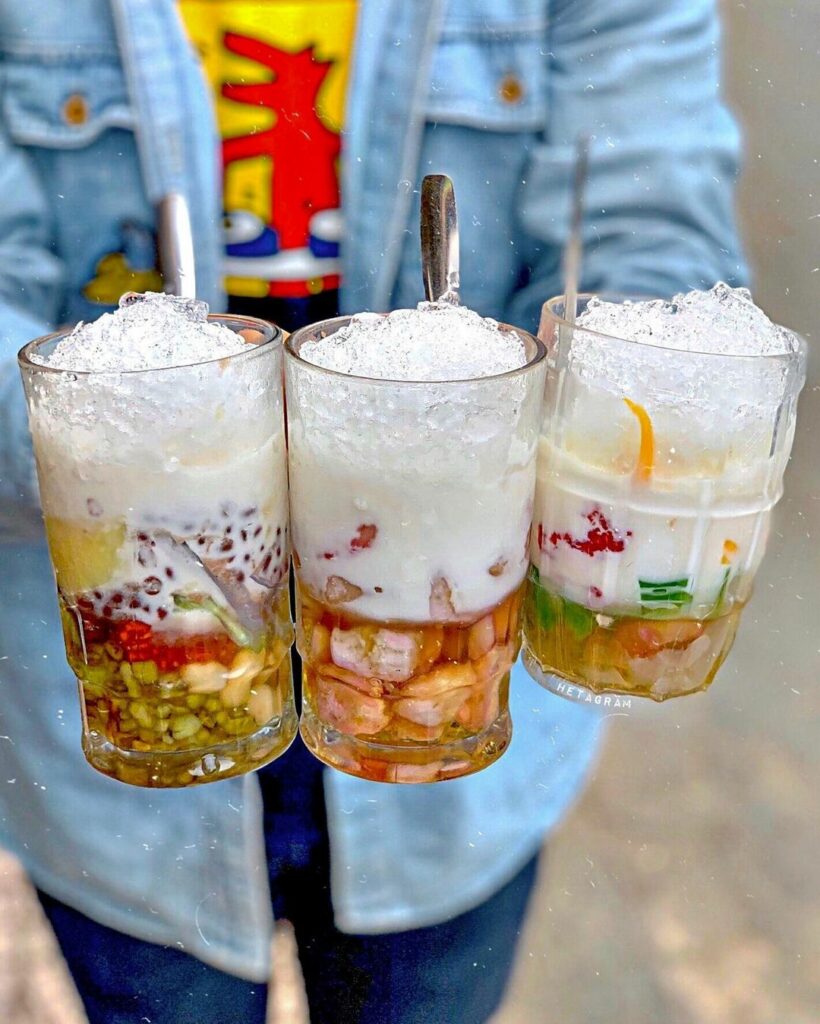
If you have leftover che thai, you can store it in the refrigerator for later consumption. Here’s how to store che thai:
- Let the che thai cool down to room temperature before storing.
- Transfer the che thai to an airtight container. Make sure the container is large enough to hold the dessert without squishing or crushing the ingredients.
- Seal the container tightly and store it in the refrigerator. “How long does che thai last” is always a question from users and che thai can be stored for up to 2-3 days in the refrigerator.
- When you’re ready to serve the che thai, take it out of the refrigerator and let it sit at room temperature for 10-15 minutes to soften.
Note: che thai contains coconut milk, which can spoil quickly if not stored properly. It is important to keep che thai refrigerated and consume it within a few days to avoid any risk of foodborne illness.
By following these simple steps, you can store che thai and enjoy it for later.
Where can I buy che thai?
If you’re looking to buy che thai, you can find it at many Vietnamese restaurants or Asian grocery stores. Here are some ways to find che thai near you:
- Search online: You can search for “che thai near me” on Google or other search engines to find Vietnamese or Asian restaurants or dessert shops that serve che thai. You can also check online food delivery services, such as Grubhub or Uber Eats, to see if they offer che thai from any local restaurants.
- Visit Vietnamese or Asian markets: You may be able to find pre-packaged or freshly made che thai at Vietnamese or Asian markets in your area. These markets often sell a variety of traditional Vietnamese desserts and ingredients.
- Che thai Lien: che thai Lien is a popular Vietnamese dessert chain
- with locations in California and Texas. They offer a variety of che thai flavors and toppings, such as durian and pandan jelly. You can check their website to see if there’s a location near you.
Che thai is a popular and widely available dessert in Vietnamese cuisine, and it shouldn’t be too difficult to find it near you. Whether you’re dining at a restaurant or shopping at an Asian grocery store, be sure to give this delicious and refreshing dessert a try.
What is the price of 1 cup of che thai?
The price of one cup of che thai can vary depending on several factors, such as the location, ingredients used, and the vendor. In Vietnam, where che thai is a popular street food, the price can range from 10,000 to 30,000 Vietnamese Dong, which is equivalent to roughly 40 cents to $1.30 USD. In the United States, where che thai is often served at Vietnamese or Asian restaurants or dessert shops, the price can range from $3 to $6 USD per cup.
It’s important to note that the price of che thai can also vary depending on the size of the cup or bowl and any additional toppings or ingredients added.
The price of che thai is relatively affordable and offers a delicious and refreshing dessert option for those looking to satisfy their sweet tooth.
FAQs
How to pronounce che thai?
For foreigners who always wonder “how to pronounce che thai”, I will show you ‘che thai’. Che thai is pronounced as “chay tie”. The “ch” sound is similar to the “ch” in “church”, while the “ay” sound is pronounced like the letter “i” in “tie”. So, the correct pronunciation of che thai is “chay tie”.
Where can I find che thai in Vietnam?
If you’re looking to find che thai in Vietnam, you’re in luck! che thai is a popular dessert in Vietnam and can be found at many local dessert shops and street food vendors. Here are some places where you can find che thai in Vietnam:
- Local dessert shops: che thai can be found at many local dessert shops throughout Vietnam, especially in larger cities such as Hanoi and Ho Chi Minh City. These shops often offer a variety of traditional Vietnamese desserts and sweets.
- Street food vendors: che thai is also popular street food in Vietnam, and you can often find vendors selling it from their carts or stalls. Look for vendors who sell a variety of colorful desserts and sweets, as they are likely to have che thai as well.
- Markets: You may also be able to find pre-packaged or freshly made che thai at markets in Vietnam. These markets often sell a variety of traditional Vietnamese foods and ingredients.
By exploring these options, you should be able to find che thai in Vietnam and experience this delicious and refreshing dessert firsthand.
Do Vietnamese eat a lot of sugar?
The amount of sugar consumed by Vietnamese people varies depending on individual dietary habits and preferences. However, like many other cultures, sugar is a common ingredient in Vietnamese cuisine and can be found in many traditional dishes and desserts.
Can che thai be served warm?
While che thai is traditionally served cold, it is possible to serve it warm if you prefer. To serve che thai warm, you can heat it gently in a saucepan over low heat or in the microwave for a few seconds until it reaches your desired temperature. Be careful not to overheat it or the ingredients may become mushy.
Serving che thai warm can be a great option during colder months or if you prefer a warm dessert. However, keep in mind that serving it warm may alter the texture and taste of the dessert slightly. Overall, whether you prefer it cold or warm, che thai is a delicious and refreshing dessert that can be enjoyed in many different ways.
Conclusion
Primarily, che thai is a colorful and delicious Vietnamese dessert that has gained popularity worldwide in recent years. While it is not a low-calorie dessert, che thai can be enjoyed in moderation as part of a balanced diet and can provide a good source of fiber and certain vitamins and minerals.
Through this article, you have explored the origin and history of che thai, its nutritional value, different variations of the dessert, and how to make and store it. I have also provided tips and substitutions for making che thai, as well as suggestions for serving and finding it in Vietnam and the United States.
Che thai is a dessert that is not only delicious but also offers a glimpse into the rich and diverse culinary traditions of Vietnam. Whether you’re a fan of traditional desserts or looking to try something new, che thai is a dessert that is definitely worth trying.